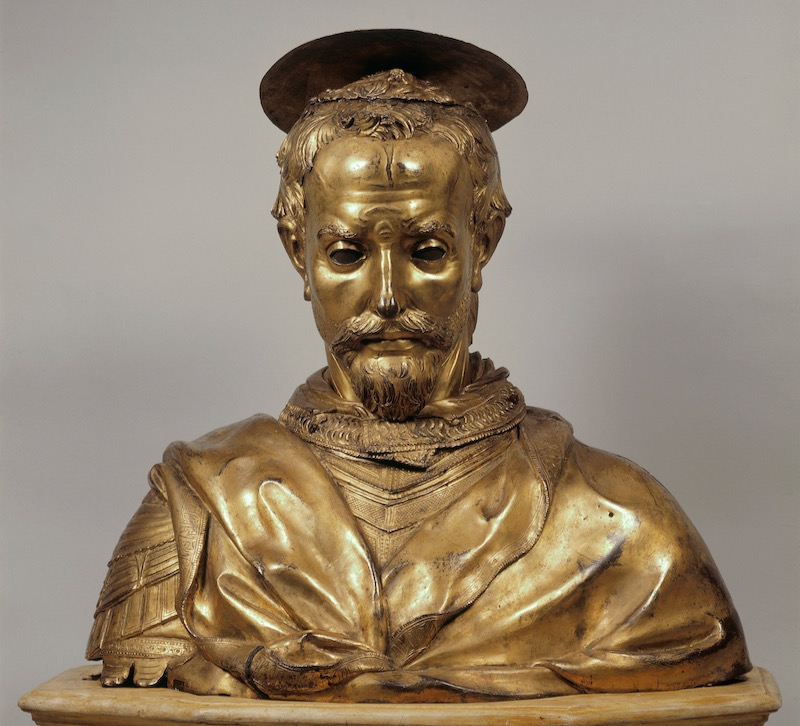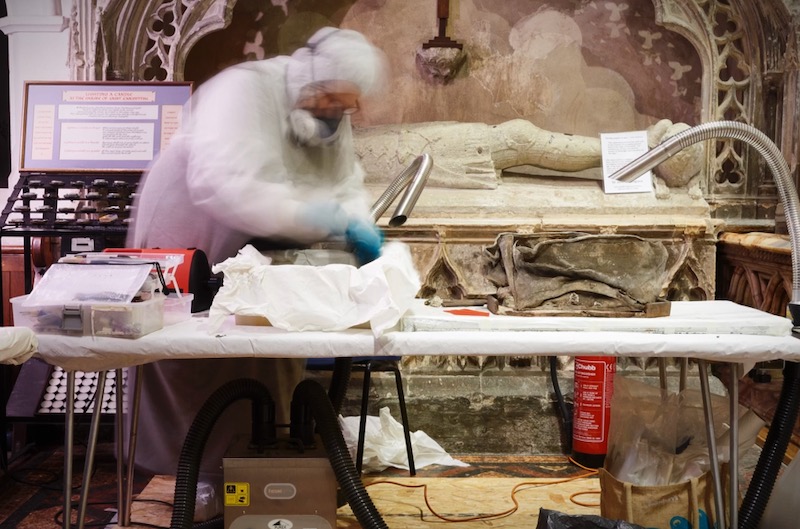In January 2020, while the world was distracted by the shadow of Covid, I was one of a small team of archaeologists, osteo-archaeologists, conservators, historians, curators, photographers and film makers who gathered at the medieval Parish church of St Mary and St Eanswythe, in Folkestone, Kent. For three days and nights, we would remain in the church, setting up and working in a sort of in situ laboratory. Our purpose was to investigate what were believed to be the relics of one of the earliest English saints.
This experience will always stick in my mind, but there were one or two scenes that stand out as essences of that extraordinary time.
One sees us gathered around a cloth covered table on which the fragile skeletal remains of someone are laid out. Although less than half of the bones were present it was still possible to see that this someone was slight and, as Dr Ellie Williams, lead osteo-archaeologist on the team, gently lifted each bone, further details of a personal osteo-biography began to emerge. This was a young woman, whose wisdom teeth had not yet erupted from her jaw, and who, most likely, had died between 17 and 19 years of age.
Beyond an adjoining door, in the vast dark central body of the church the lead conservator, Dana Goodburn Brown, was sitting in a white forensic suit in pool of light. Dana was peering closely down a microscope at tiny particles that had accumulated around the bones. Shavings of what looked like gold (but were in fact brass) curled like flowers. Besides Dana was the remains of a battered lead casket, probably made from reused panels of a Roman lead coffin, patterned, as Dana showed us, by imprinting the edge of a scallop shell into its surface and re-formed as a vessel in the eighth or ninth century.
The bones and their casket had been discovered by builders, concealed within a wall, in 1885, when the church was being “beautified”. They were immediately hailed as being the holy remains of St Eanswythe, an Anglo-Saxon princess who had lived at the dawn of English Christianity. The child of King Eadbald and Queen Emma of Kent, granddaughter of Ethelbert and Bertha who welcomed Augustine, Eanswythe was recorded as having founded a minster at Folkestone. As patron saint of the town, she had become the personal protectoress and advocate for the people of Folkestone and pilgrims who visited her shrine.
Eanswythe as an individual was, we assumed, too hard to reach, but fascinating patterns of continuity, remembrance and forgetting surrounded her. Eanswythe’s memory had survived in the consciousness of the community, not only in veneration but also in art, history and legend that lived on long after the Reformation had destroyed her shrines and her reliquary had been sold off and probably melted down.
Perhaps the most powerful evidence of Eanswythe’s continuing presence in the town was this supposed survival of her relics. Was it possible that, unlike almost any other pre-Reformation Saint, they had survived, concealed from Cromwell’s visitations and the burning and grinding destruction that followed? This is what we wanted to discover on that cold January. This was an opportunity for the science of the 21st century to throw light on unanswered questions. We observed with enormous care and open minds as tiny fragments of bone and tooth were taken and sent to laboratories in Belfast, London and Oxford for carbon 14 dating, isotopic analysis and DNA testing. And then we waited.
The results confirmed that long-held faith had been well founded and made tangible and accessible the focus of 14 centuries of veneration.
The bones found in the wall were indeed of a young woman uncontaminated by any other remains; she had eaten a higher status diet, likely drunk the water of East Kent and, above all, a combination of historical and scientific dating suggested that she had died at just the “right” time between 653 and 663. With overwhelming confidence, we now knew that Eanswythe had, after all, been found.
What though, for many of us, was most remarkable was not the science alone but rather the feeling that these three days of attentive study of the relics had left with us. We were a mixed team and although I am a priest as well as historian, most of us there were not religious believers. Yet many of us shared a sense that there was something different about this process.
As Dr Andrew Richardson, lead archaeologist on the team, has recently put it: “I’ve worked with a lot of bones in my time, and I’ve dug up a lot of things from the past, but when we laid those bones out in that vestry there was a strange, palpable sense of the presence of Eanswythe... there was something different about those bones.” I too felt something like the presence of Eanswythe – she was so much at the centre of our work and, as I later reflected, our work felt like a service for her.
Some two years later we began a new project. “Three Days in January” sought to understand better this experience and to ask in what ways some objects and sites appear to retain a sense of connection, encounter or timelessness. One central strand to emerge is the importance of memory and veneration, even when disrupted by centuries. Some sites it seems may be palimpsests, etched and overwritten by loving attention in a way that gives them a distinctive identity, and our feeling of reverence or connection to them is something deeply woven into our culture, history and identity.
On one cold evening that January we listened while Andrew read Edith Nesbit’s ghost story, Man-Size in Marble, set at another church dedicated to Eanswythe: St Eanswith’s, Brenzett, on the Romney Marsh. The opening line sticks in my mind: “Although every word of this story is as true as despair, I do not expect people to believe it.”
There is no expectation of belief here, that’s important to say, but there is a willingness to consider with open minds, to record and to better understand the processes in play and to ask what they still might mean for us.
Rev’d Dr Lesley Hardy is an Honorary Research Fellow in the Department of History and American Studies at Canterbury Christchurch University. She is a member of the “Three Days in January” project team, part of the Equipping Christian Leadership in an Age of Science programme led by Durham University and funded by the Templeton Religion Trust.
A film documenting the team’s experiences through the ‘Three Days in January’ project is available to watch here.



 Loading ...
Loading ...
What do you think?
You can post as a subscriber user ...
User comments (0)